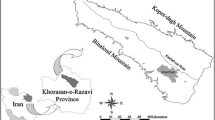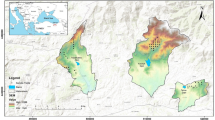Abstract
Soil erodibility factor (susceptibility of soil to be lost to erosion) is one of the components of the universal soil loss equation. This study presents an artificial neural network (ANN) model using 74 soil series provided by the Department of Agriculture, Malaysia. The ANN model produces acceptable results: the K values for 74 soil series of Peninsular Malaysia give much better information to engineers in determining the soil loss and sediment yield for a given development area.



Similar content being viewed by others
References
ASCE Task Committee (2000) Artificial neural networks in hydrology. I. Preliminary concepts. J Hydraul Eng ASCE 5(2):115–123
Azmathullah HMd, Deo MC, Deolalikar PB (2005) Neural networks for estimation of scour downstream of ski-jump bucket. J Hydraul Eng 131(10):898–908
Azmathullah HMd, Deo MC, Deolalikar PB (2006) Estimation of scour below spillways using neural networks. J Hydraul Res 44(1):61–69
Azamathulla HMd, Deo MC, Deolalikar PB (2008) Alternative neural networks to estimate the scour below spillways. Adv Eng Softw Elsevier 39(8):689–698
Bowden GJ, Maier HR, Dandy GC (2002) Optimal division of data for neural network models in water resources applications. Water Resour Res 38(2):1–11
Dawson CW, Wilby R (1998) An artificial neural network approach to rainfall-runoff modeling. Hydrol Sci 43(1):47–66
Department of Agriculture (DOA) (2010) Soil survey data for peninsular Malaysia
Department of Irrigation and Drainage (DID) (2010) Guideline for erosion and sediment control in Malaysia
Department of Agriculture (1995) Guideline for soil series of peninsular Malaysia
Garde RJ (2006) River morphology. New Age international Publications, India
Guven A, Azamathulla HMd, Zakaria NA (2009) Linear genetic programming for prediction of circular pile scour. J Ocean Eng 36(12–13):985–991
Guven A, Gunal M (2008) Genetic programming approach for prediction of local scour downstream hydraulic structures. J Irrig Drain Eng 134(2):241–249
Guven A, Aytek A, Yuce MI, Aksoy H (2008) Genetic programming based empirical model for daily reference evapotranspiration estimation. Clean Soil Air Water 36(10–11):905–912
Hashim GM, Wan Abdullah WY (2005) Prediction of soil and nutrient losses in a highland catchment, Malaysia Agriculture Research and Development Institute (MARDI). Water Air Soil Pollut Focus 5:103–113
Haykin S (1994) Neural networks: a comprehensive foundation. MacMillan, New York
Hornik K, Stinchcombe M, White H (1989) Multilayer feed-forward networks are universal approximators. Neural Netw 2:359–366
Jain SK (2001) Development of integrated sediment rating curves using ANNs. J Hydraul Eng ASCE 127(1):30–37
Kisi O, Guven A (2010) A machine code-based genetic programming for suspended sediment concentration estimation. Adv Eng Softw 41(7–8):939–945
Kisi O, Yuksel I, Dogan E (2008) Modelling daily suspended sediment of rivers in Turkey using several data driven techniques. Hydrol Sci J 53(6):1270–1285
Licznar P, Nearing MA (2003) Artificial neural networks of soil erosion and runoff prediction at the plot scale. CATENA, Catena 51(2003):89–114
Morgan RCP (1996) Soil erosion and conservation, 2nd edn. Longman Publisher, London
Tew KH (1999) Production of Malaysian soil erodibility nomograph in relation to soil erosion issues. VT Soil Erosion Research & Consultancy, Malaysia
United State Department of Agriculture (USDA) (1983). National soil handbook
United State Department of Agriculture (USDA) (1972) National engineering handbook
United State Geology and Soils (USGS) Ontario Centre for Soil Resource Evaluation 1993
Wischmeier WH, Johnson CB, Cross BV (1971) A soil erodibility nomograph for farmland and constructions. J Soil Water Conserv 26:189–193
Wischmeier WH, Smith DD (1978) Predicting rainfall erosion losses. A guide to conservation planning, USDA-SEA, US. Governmental Printing Office, Washington
Yusof MF, Abdullah R, Azamathulla HMd, Zakaria NA, and Ghani AAb (2011) Modified soil erodibility factor, K for peninsular Malaysia soil series. In: International conference on managing rivers in the 21st century, Penang, Malaysia, Dec 6–9, 2011
Acknowledgments
We would like to thank Department of Irrigation and Drainage (DID) Malaysia and Department of Agriculture (DOA) Malaysia and REDAC, Universiti Sains Malaysia for giving the opportunity in carry out the research and study. This is part of MSc Thesis progress report of first author.
Author information
Authors and Affiliations
Corresponding author
Rights and permissions
About this article
Cite this article
Yusof, M.F., Azamathulla, H.M. & Abdullah, R. Prediction of soil erodibility factor for Peninsular Malaysia soil series using ANN. Neural Comput & Applic 24, 383–389 (2014). https://doi.org/10.1007/s00521-012-1236-3
Received:
Accepted:
Published:
Issue Date:
DOI: https://doi.org/10.1007/s00521-012-1236-3




